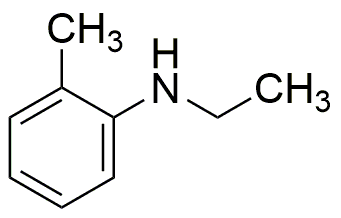N-Ethyl-o-toluidine is widely utilized in research focused on:
- Dyes and Pigments: This compound serves as an intermediate in the synthesis of azo dyes, which are extensively used in textiles and printing industries for their vibrant colors and stability.
- Pharmaceuticals: It plays a role in the production of various pharmaceutical compounds, particularly in the development of analgesics and anti-inflammatory agents, providing a foundation for effective medicinal formulations.
- Polymer Chemistry: N-Ethyl-o-toluidine is used in the production of polymer additives, enhancing properties like durability and resistance to environmental factors, which is crucial for manufacturing high-performance materials.
- Analytical Chemistry: This chemical is utilized as a reagent in various analytical methods, aiding in the detection and quantification of other compounds, which is essential for quality control in laboratories.
- Research Applications: It is often employed in organic synthesis and chemical research, providing researchers with a versatile tool for exploring new chemical reactions and developing innovative compounds.
General Information
Properties
Safety and Regulations
Applications
N-Ethyl-o-toluidine is widely utilized in research focused on:
- Dyes and Pigments: This compound serves as an intermediate in the synthesis of azo dyes, which are extensively used in textiles and printing industries for their vibrant colors and stability.
- Pharmaceuticals: It plays a role in the production of various pharmaceutical compounds, particularly in the development of analgesics and anti-inflammatory agents, providing a foundation for effective medicinal formulations.
- Polymer Chemistry: N-Ethyl-o-toluidine is used in the production of polymer additives, enhancing properties like durability and resistance to environmental factors, which is crucial for manufacturing high-performance materials.
- Analytical Chemistry: This chemical is utilized as a reagent in various analytical methods, aiding in the detection and quantification of other compounds, which is essential for quality control in laboratories.
- Research Applications: It is often employed in organic synthesis and chemical research, providing researchers with a versatile tool for exploring new chemical reactions and developing innovative compounds.
Documents
Safety Data Sheets (SDS)
The SDS provides comprehensive safety information on handling, storage, and disposal of the product.
Product Specification (PS)
The PS provides a comprehensive breakdown of the product’s properties, including chemical composition, physical state, purity, and storage requirements. It also details acceptable quality ranges and the product's intended applications.
Certificates of Analysis (COA)
Search for Certificates of Analysis (COA) by entering the products Lot Number. Lot and Batch Numbers can be found on a product’s label following the words ‘Lot’ or ‘Batch’.
*Catalog Number
*Lot Number
Certificates Of Origin (COO)
This COO confirms the country where the product was manufactured, and also details the materials and components used in it and whether it is derived from natural, synthetic, or other specific sources. This certificate may be required for customs, trade, and regulatory compliance.
*Catalog Number
*Lot Number
Safety Data Sheets (SDS)
The SDS provides comprehensive safety information on handling, storage, and disposal of the product.
DownloadProduct Specification (PS)
The PS provides a comprehensive breakdown of the product’s properties, including chemical composition, physical state, purity, and storage requirements. It also details acceptable quality ranges and the product's intended applications.
DownloadCertificates of Analysis (COA)
Search for Certificates of Analysis (COA) by entering the products Lot Number. Lot and Batch Numbers can be found on a product’s label following the words ‘Lot’ or ‘Batch’.
*Catalog Number
*Lot Number
Certificates Of Origin (COO)
This COO confirms the country where the product was manufactured, and also details the materials and components used in it and whether it is derived from natural, synthetic, or other specific sources. This certificate may be required for customs, trade, and regulatory compliance.


